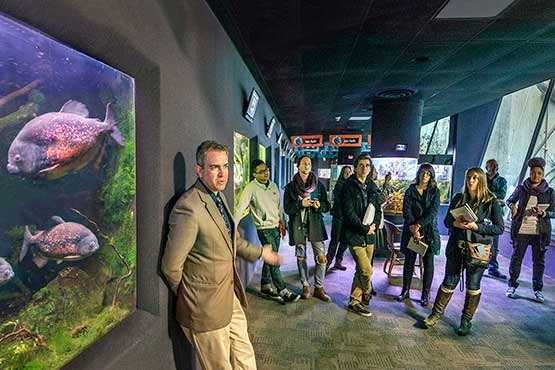
News . Feature Stories . Real-world assignment: CIA students tackle re-design of Cleveland Metroparks Zoo's Primate, Cat and Aquatics Building
News
October 26, 2015
Real-world assignment: CIA students tackle re-design of Cleveland Metroparks Zoo's Primate, Cat and Aquatics Building
Students to propose refinements that would improve visitor engagement

Cleveland Metroparks Zoo is collaborating with CIA’s Interior Architecture students for some fresh design ideas for its nearly 30-year-old Primate, Cat and Aquatics Building.
The assignment has students considering a long checklist of requirements, including the zoo’s commitment to animal welfare, the practicalities of keeping animal facilities clean, the best ways to make the space inviting and educational for visitors of all ages, and upgrades needed to make the space appealing for special events.
“What can we do to the space to make it more engaging, to freshen it up, make it more comfortable and inviting,” Zoo Director Christopher Kuhar, Ph.D. (above at left), asked students when he visited CIA last month.
Kuhar said the facility was built in 1978. It houses one of the largest collections of primate species in North America (although not the zoo's entire primate population), as well as cheetahs, fossas, rare snow leopards and 35 saltwater and freshwater aquatics exhibits. On a busy summer day, the building can attract up to 18,000 visitors.
In addition to serving as a resource for science and conservation education, the facility is also rented out for cocktail parties, dinners, winter formals and even weddings.
In October, students visited the building, photographed the spaces, and took copious notes as Kuhar gave a tour.
Associate Professor Michael Gollini said the project will be tremendously valuable for students.
“When our students have the opportunity to work with real clients like the Cleveland Metroparks Zoo, the experience gives them a taste of what their future professional careers will be like. When we get to work on an actual job site the classroom project gets elevated to a whole new level. Real clients and real sites add a professional dynamic to the project making the students work that much harder.”
He said zoo officials will return to CIA in early November to review initial design drafts, and in early December to review final designs.
“This kind of interaction not only sharpens students’ design skills, it also give them a chance to strengthen their ‘soft skills,’ that is, how they communicate and interact with people, which is just as important as their creative skills.”
Last year Interior Architecture majors created designs for a co-working space in Cleveland’s Health Tech Corridor.
The zoo project is an example of Cores + Connections, CIA's academic vision in which core values of world-class faculty mentorship, studio and academic rigor, cutting edge curriculum, and state-of-the-art facilities power extensive connections for student engagement in field-based hands-on learning, real-world professional projects, and community-based practices in art and design.
Latest Headlines view all
-
April 02, 2024
Cleveland Institute of Art students partner with Progressive Art Collection to exhibit Ready, Set, Relay! -
March 04, 2024
Cleveland Institute of Art announces Curlee Raven Holton Inclusion Scholar Program -
November 06, 2023
Collision of art and artificial intelligence creates murky waters for artists, curators and educators
Questions?
For more information about this or other CIA news, contact us here.
Social Feed